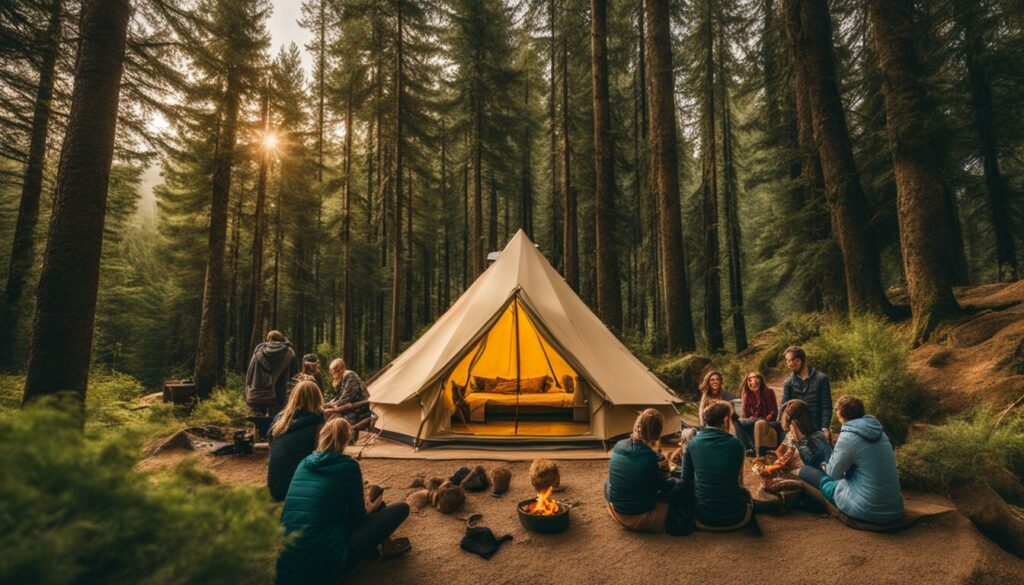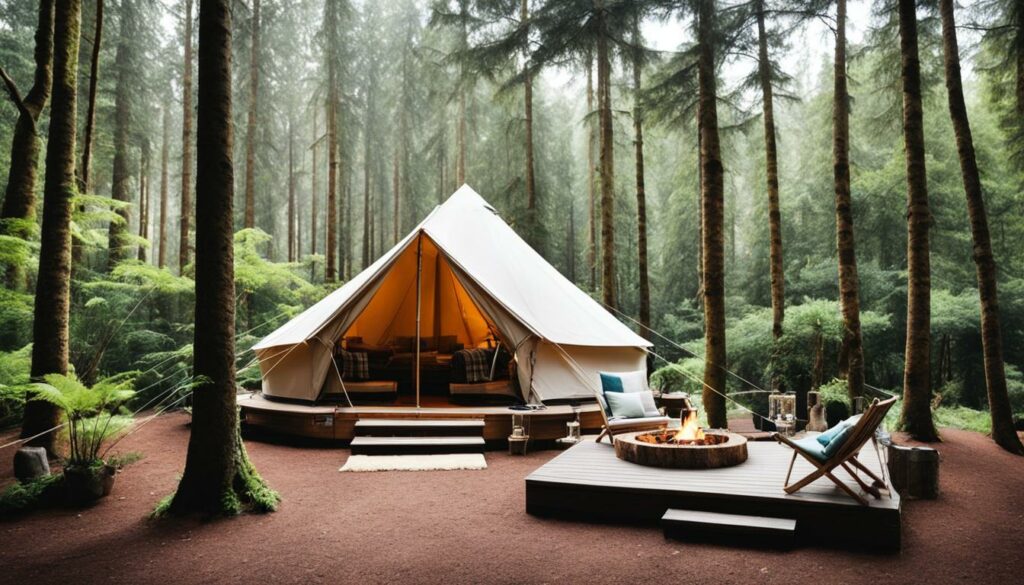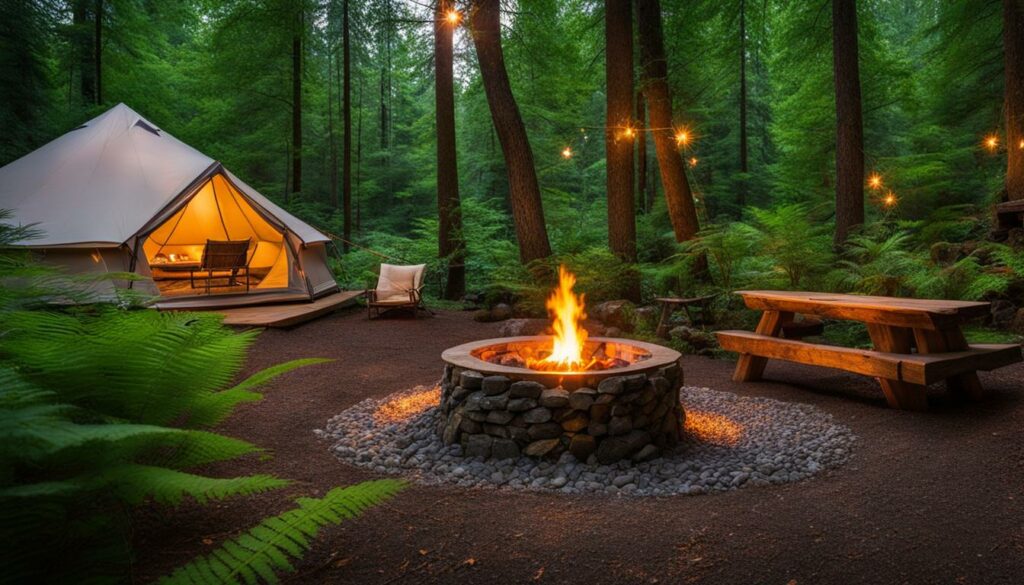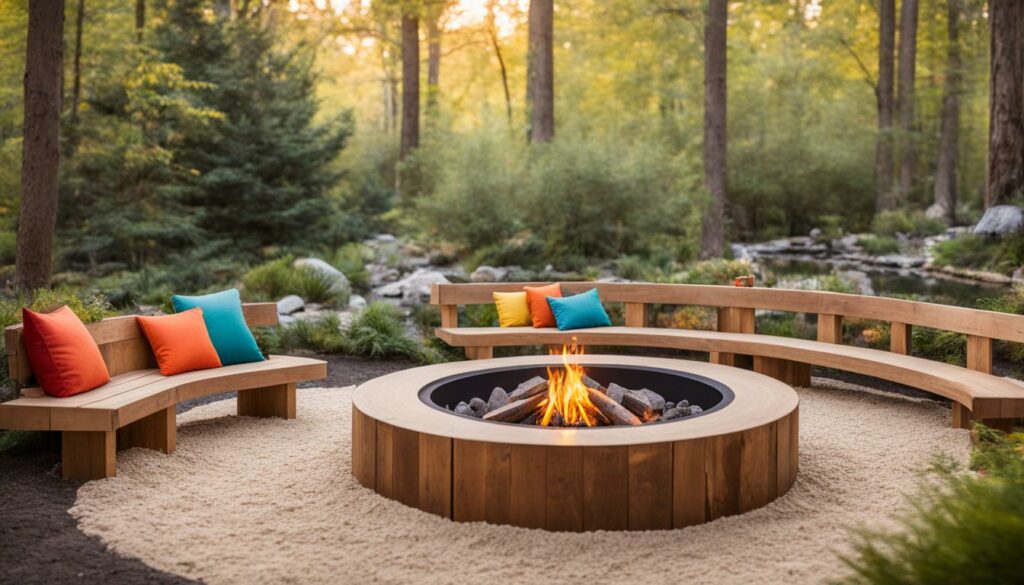Glamping is becoming an increasingly popular trend in the travel industry. However, for individuals with sensory sensitivities, the idea of camping in the great outdoors can be anxiety-inducing and overstimulating, making it a less-than-ideal vacation option. This is where sensory-friendly glamping sites come in, offering a tranquil and inclusive outdoor experience.
In this article, we will explore the importance of creating sensory-friendly glamping sites and provide tips and techniques on how to design and offer accessible accommodations for sensory-sensitive individuals.
Key Takeaways
- Sensory-friendly glamping sites provide a welcoming and inclusive outdoor experience for individuals with sensory sensitivities.
- Design and layout aspects such as lighting, soundproofing, and natural elements are crucial to making accommodations accessible and calming for sensory-sensitive individuals.
- Offering sensory-friendly activities and amenities, as well as training staff and partnering with sensory-friendly organizations, are important factors to consider when creating a sensory-friendly glamping site.
- Continuous feedback from guests and continuous improvement are essential for creating an ever-improving sensory-friendly experience.
- Creating sensory-friendly glamping sites not only benefits individuals with sensory sensitivities but also promotes inclusivity and diversity in the travel industry.
Understanding Sensory Sensitivities

Sensory sensitivities are common in individuals, making them experience an intense response to stimuli that others may not perceive or find bothersome. Sensory-sensitive individuals may experience discomfort, agitation, or overwhelm due to factors such as lighting, sounds, textures, tastes, and smells.
Sensory-friendly accommodations can help address and minimize these sensitivities, providing a safe and comfortable environment for individuals. For example, using natural and calming colors, soft and comfortable textures, reducing the glare and noise, and eliminating strong smells can prove beneficial.
Building sensory-friendly accommodations depends on understanding the different ways that individuals might experience sensitivities. Some might be hypersensitive or oversensitive, while others might be hyposensitive or under-sensitive. Hypersensitive individuals have heightened sensitivity levels, and their experience can be uncomfortable or painful, while hyposensitive individuals may crave intense sensory input as they might not perceive it as easily.
It is essential for glamping sites to understand that creating sensory-friendly accommodations is beyond adapting to the Americans with Disabilities Act (ADA) guidelines. Sensory-sensitive individuals face different barriers that are not covered under ADA guidelines. Hence, accommodations such as a portable sensory room, a quiet sensory-friendly campfire area, and natural therapeutic options like horse therapy can help provide an inclusive environment to such guests.
Designing for Sensory Accessibility

Creating sensory-friendly accommodations within natural settings requires thoughtful design that caters to the unique needs of sensory-sensitive individuals. A well-designed space can provide a soothing and calming environment that allows guests to fully immerse themselves in the beauty of nature without being overwhelmed.
Consideration should be given to factors such as layout, lighting, and soundproofing to ensure that sensory-friendly accommodations are accessible and welcoming to all. For instance, ensuring that rooms have ample natural light can contribute to a comfortable and uplifting atmosphere, while soft, warm lighting can help to create a cozy and inviting space.
Soundproofing measures, such as using double-paned windows and insulating walls, can help to minimize outside noise and provide a more peaceful environment. Additionally, incorporating nature-inspired materials like wooden furniture and decor can enhance the sensory experience and create a cohesive design aesthetic.
| Design Factors to Consider | How They Benefit Sensory-Sensitive Individuals |
|---|---|
| Layout | A well-organized and spacious layout helps individuals with sensory sensitivities move around with ease and reduces clutter and overstimulation. |
| Lighting | Different lighting options – natural, dimmed, and warm lights – can help create a sensory-friendly space that is easy on the eyes, resulting in a relaxed atmosphere. |
| Soundproofing | Soundproofing measures such as double-pane windows can help to minimize outside noise and minimize disruptions that might trigger individuals’ sensory sensitivities. |
| Nature-Inspired Design | Natural design elements like wooden furniture, decorative elements, and color palettes create a calming, relaxing environment and add to the sensory-friendly experience. |
A sensory-friendly layout also means designing a space that is easy to navigate with well-placed signage and ample visual cues, including colors and textures, that help individuals orient themselves within unfamiliar surroundings. It can also be beneficial to ensure that all areas of the space are wheelchair-friendly, including bathrooms and outdoor areas.
By incorporating the right design elements and factors, designers and site managers can create inclusive, accessible glamping sites that ensure guests with sensory sensitivities can experience nature and enjoy sensory-friendly camping experiences with comfort and freedom.
Incorporating Natural Elements

Sensory-friendly glamping sites can create a calming and inclusive atmosphere by incorporating natural elements. Using nature-inspired materials, textures, and colors can enhance the overall experience of accessible and inclusive glamping sites. Natural elements such as wood, stone, and greenery can provide guests with sensory-friendly accommodations that complement the surrounding natural environment.
Inclusive glamping sites can incorporate natural elements in various ways. For example, using natural colors and patterns in bedding and upholstery, such as earth tones and floral designs, can provide a welcoming and soothing environment. Sensory-friendly travel destinations can also use natural elements in their landscaping by incorporating sensory gardens with plants that have unique textures, smells, and tastes.
Incorporating natural elements also has practical benefits. Using local and sustainable materials can reduce the environmental impact of sensory-friendly camping experiences. It can also create a sense of connection to the surrounding landscape, providing guests with a memorable and authentic outdoor experience.
Example: Inclusive Glamping Site Materials
| Material | Benefits |
|---|---|
| Bamboo | A sustainable and eco-friendly alternative to wood. |
| Recycled Textiles | Provides a way to reuse materials, reducing environmental waste. |
| Reclaimed Wood | Creates a rustic and natural aesthetic, while using existing resources. |
| Natural Fibers | Has unique textures that can be soothing and comforting, providing a sensory-friendly experience. |
Sensory-friendly camping experiences can benefit from incorporating natural elements in various aspects of the accommodations. By using eco-friendly and locally-sourced materials, inclusive glamping sites can create a relaxing and sustainable environment that promotes sensory well-being.
Sensory-Friendly Activities and Amenities

Offering a range of sensory-friendly activities and amenities can greatly enhance the experience of guests staying in sensory-friendly outdoor accommodations and sensory-friendly luxury camping sites.
One of the most popular activities is going on nature walks, where guests can explore the natural beauty of the surrounding environment at their own pace. Relaxation areas are also important for guests to unwind and recharge. These areas can include quiet spaces, meditation gardens, and even sensory-friendly hammocks and swings.
Sensory-friendly dining experiences can also be a game-changer for sensory-sensitive individuals. These experiences typically involve food that is easy to digest, low in fat, and free of any triggering flavors or textures. Some campsites also offer cooking classes, where guests can learn how to prepare their own sensory-friendly meals.
Additionally, water-based activities such as swimming, canoeing, and kayaking can also be enjoyed in a sensory-friendly manner. By providing guests with access to calm and quiet bodies of water or gentle rivers, they can have an enjoyable and soothing outdoor experience.
“Offering a range of sensory-friendly activities and amenities can greatly enhance the experience of guests staying in sensory-friendly outdoor accommodations and sensory-friendly luxury camping sites.”
Staff Training and Sensory Awareness
Creating sensory-friendly accommodations requires more than just designing and building accessible structures. It also involves ensuring that the staff members providing services have received adequate training and possess the necessary skills to interact with sensory-sensitive guests in a welcoming and supportive manner.
Training staff members on how to recognize the signs of sensory overload and how to respond to them appropriately is crucial in creating a comfortable and safe environment for all guests. Staff members should also be encouraged to develop a sense of empathy and understanding towards guests with sensory sensitivities, which can be achieved through regular training sessions and workshops.
Moreover, it is important to make sure that staff members are aware of the specific accommodations available for sensory-sensitive guests and how they can assist them in accessing these facilities. Providing clear guidelines and resources can be beneficial in helping staff members understand the unique needs of each guest, and in turn, tailor their service accordingly.
“Ensuring that staff members receive adequate training and possess the necessary skills to interact with sensory-sensitive guests in a welcoming and supportive manner is crucial in creating a comfortable and safe environment for all guests.”
By prioritizing staff training and sensory awareness, glamping sites for sensory-sensitive individuals can create a warm and inclusive atmosphere that guests will appreciate. With compassionate and knowledgeable staff members, sensory-friendly camping experiences can become a reality for more individuals seeking a peaceful and rejuvenating nature retreat.
Partnering with Sensory-Friendly Organizations
Partnering with sensory-friendly organizations can provide glamping sites with valuable insights and resources to enhance the overall sensory-friendly experience for guests. These organizations specialize in creating inclusive and welcoming environments for individuals with sensory sensitivities, from designing accommodations to offering activities and amenities that cater to their needs.
“Collaborating with sensory-friendly organizations allowed us to better understand the challenges and preferences of sensory-sensitive travelers. This knowledge helped us to create accommodations that are comfortable and calming, with thoughtful design details that promote a sense of tranquility and relaxation,” says Jane Smith, owner of Nature’s Retreat, an inclusive glamping site in Vermont.
The Benefits of Partnering with Sensory-Friendly Organizations
Partnering with sensory-friendly organizations can bring numerous benefits to glamping sites that want to provide a sensory-friendly experience to their guests:
| Benefit | Description |
|---|---|
| Professional expertise | Partnering with organizations that specialize in sensory-friendly accommodations can provide glamping sites with professional expertise and guidance in creating an accessible and comforting environment for individuals with sensory sensitivities. |
| Networking opportunities | Collaborating with sensory-friendly organizations can also lead to networking opportunities with other businesses and individuals who share the same goal of promoting sensory-friendly travel destinations and nature retreats. |
| Marketing advantages | Partnering with well-known sensory-friendly organizations can help glamping sites to gain exposure and attract new guests who are looking for accessible and inclusive vacation experiences. This can lead to increased bookings and revenue. |
Overall, partnering with sensory-friendly organizations can be a valuable strategy for glamping site owners looking to create sensory-friendly nature retreats and accommodate individuals with sensory sensitivities.
Feedback and Continuous Improvement
Creating sensory-friendly glamping sites requires ongoing attention and dedication to continuously evolving and improving the experience for sensory-sensitive individuals. This involves actively seeking feedback from guests and incorporating their suggestions into future design and amenities.
Through regular surveys, feedback forms, and direct communication, glamping site owners can gain valuable insights into the specific needs and preferences of their sensory-sensitive guests. This feedback can inform adjustments to accommodations and amenities, such as providing additional soundproofing, adjusting lighting levels or implementing sensory-friendly activities and menus.
Continuously seeking to improve and enhance sensory-friendly glamping sites ensures that guests have the best possible outdoor experience in a relaxing and inclusive environment. By striving to meet the evolving needs of individuals with sensory sensitivities, glamping site owners can establish their sites as top-rated, sensory-friendly luxury camping destinations that cater to a diverse range of guests.
Conclusion
The creation of sensory-friendly glamping sites is a crucial step towards providing inclusive and accessible outdoor accommodations for sensory-sensitive individuals. By understanding the diverse range of sensory sensitivities and incorporating design elements that address these needs, glamping sites can offer a tranquil and enjoyable experience for all guests.
By including natural elements, sensory-friendly activities and amenities, and partnering with sensory-friendly organizations, glamping sites can create a supportive and welcoming environment for all. Continuous improvement through gathering guest feedback and staff training can further enhance the sensory-friendly experience.
Overall, the creation of sensory-friendly glamping sites is a positive step towards promoting inclusivity and accessibility in outdoor travel. With these tips and techniques, individuals with sensory sensitivities can enjoy the beauty of nature without sacrificing their comfort and wellbeing.
FAQ
What are sensory-friendly glamping sites?
Sensory-friendly glamping sites are accommodations that are specially designed to cater to the needs of sensory-sensitive individuals. These sites create a tranquil and inclusive environment by considering factors such as lighting, sound, layout, and overall accessibility.
Why are sensory-friendly accommodations important?
Sensory-friendly accommodations are important because they provide a comfortable and enjoyable experience for individuals with sensory sensitivities. These accommodations allow individuals to fully immerse themselves in nature while minimizing potential triggers that can cause distress or discomfort.
How can sensory-friendly glamping sites address sensory sensitivities?
Sensory-friendly glamping sites can address sensory sensitivities by incorporating design elements that reduce sensory overload. Factors such as natural materials, subdued lighting, soundproofing, and flexible layouts can create a calming and accessible environment for individuals with sensory sensitivities.
What are some examples of sensory-friendly activities at glamping sites?
Sensory-friendly activities at glamping sites can include nature walks, relaxation areas, and sensory-friendly dining experiences. These activities are designed to provide opportunities for individuals to connect with nature in a soothing and inclusive manner.
How can staff training contribute to a sensory-friendly environment?
Staff training plays a crucial role in fostering a sensory-friendly environment. By receiving training on sensory awareness, staff members can better understand the needs of individuals with sensory sensitivities and provide appropriate support and accommodation throughout their stay.
What are the benefits of partnering with sensory-friendly organizations?
Partnering with sensory-friendly organizations allows glamping sites to access valuable insights and resources in creating and promoting a sensory-friendly environment. These partnerships can enhance the overall experience and ensure that accommodations are tailored to the specific needs of sensory-sensitive individuals.
How can guest feedback contribute to continuous improvement at sensory-friendly glamping sites?
Gathering feedback from guests is essential for continuous improvement at sensory-friendly glamping sites. By listening to the experiences and suggestions of individuals with sensory sensitivities, accommodations can be adjusted and refined to better meet their needs and enhance the overall experience.





